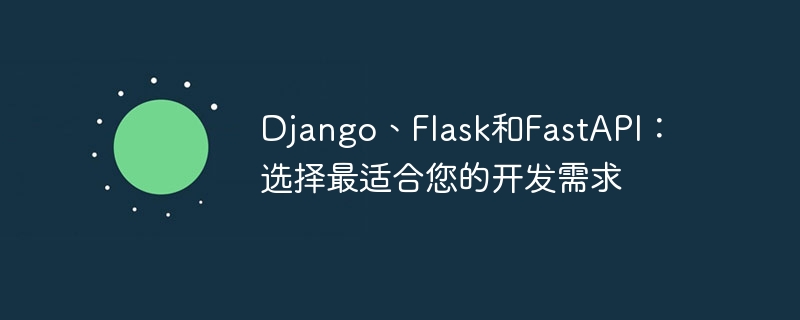

Django, Flask, and FastAPI: Choose the best fit for your development needs, specific code examples required
Introduction:
In modern web development, choosing the right one The framework is crucial. As Python continues to develop in the field of web development, frameworks such as Django, Flask and FastAPI are becoming more and more popular among developers. This article will introduce the characteristics and applicable scenarios of these three frameworks, combined with specific code examples, to help you choose the framework that best suits your development needs.
1. Django:
Django is a full-featured web development framework that focuses on quickly building high-quality, scalable web applications. It provides a powerful ORM (Object Relational Mapping) and template engine, allowing developers to manage databases and create user interfaces more easily.
Applicable scenarios:
Sample code:
The following is a sample code for using Django to create a simple blog application:
1 2 3 4 5 6 7 8 9 10 11 12 13 14 15 16 17 18 19 20 21 22 23 24 25 26 27 28 29 |
|
2. Flask:
Flask is a lightweight A web framework that focuses on simplicity and flexibility. It provides basic functions and tools, allowing developers to customize it according to their own needs. Flask does not have a built-in ORM and template engine, but it can be easily integrated with other third-party libraries.
Applicable scenarios:
Sample code:
The following is a sample code for using Flask to create a simple blog application:
1 2 3 4 5 6 7 8 9 10 11 12 13 14 15 |
|
3. FastAPI:
FastAPI is a modern Web Framework focused on quickly building high-performance web applications. It is based on Python 3.7's type hints and asynchronous IO, and supports automatic generation of API documents and powerful request parameter verification.
Applicable scenarios:
Sample code:
Here is a sample code for creating a simple blogging API using FastAPI:
1 2 3 4 5 6 7 8 9 10 11 12 13 14 15 16 17 18 19 20 21 22 23 |
|
Conclusion:
Before choosing a framework that suits your development needs When doing this, factors such as project scale, data operation requirements, and performance requirements need to be taken into consideration. Django is suitable for developing large and complex web applications; Flask is suitable for quickly building small applications; FastAPI is suitable for high-performance API development. Depending on your specific needs, choosing the most suitable framework will help improve development efficiency and project quality.
We hope that the introduction and sample code of this article can help you choose the framework that best suits your development needs and achieve good results in actual development.
The above is the detailed content of Django, Flask, and FastAPI: Choose the one that best suits your development needs. For more information, please follow other related articles on the PHP Chinese website!




